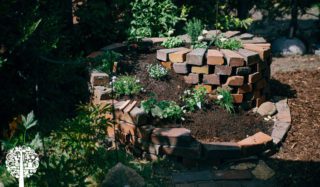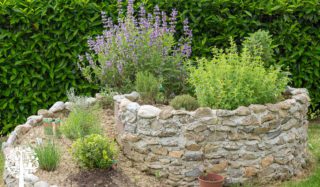Growing Herbs In A Spiral Guided By The Sun
Adding fresh herbs from the garden to any dish elevates its flavor level. But growing these tasty plants can be tricky. For example, sage prefers dry soil and hot temperatures, while oregano or parsley love a cooler, shaded environment. It can be challenging to find the right location for them all to grow happily together.
Enter The Spiral Garden
Herb spirals use permaculture growing principles and provide dry, arid conditions alongside shade and moisture. These circular structures, reminiscent of a spiral staircase, add character to the gardenscape, work well in smaller gardens, and bring all those tasty herbs together in one spot.
How An Herb Spiral Works
You can create microclimates by planting your herbs in a pattern that follows the sun’s daily movement. For example, herbs grown at the top/center of the structure are exposed to the sun longer during the day, and the soil dries out faster.
Those planted against the east or west-facing walls receive either morning sun and afternoon shade or vice versa. By watering the spiral from the top, you naturally drain the water through the structure; the top layers will stay drier than at the bottom, where moisture accumulates.
Getting Started
Building an herb spiral is a straightforward process. First, find a patch of level ground in an area that gets a good amount of sun.
In the Northern Hemisphere, the spiral should circle clockwise from the center, with the lowest point oriented towards the north; this will be the place that naturally receives less sunlight, and therefore, more shade and less water evaporation occur.
Step 1: Extend a string from the center point of where your structure will be placed to create a circle. It’s the same idea as using a protractor to create a circumference. The average size of an herb spiral is typically between 1.5 to 3 meters in diameter or 0.5-1.5 meters from the center in all directions, and about a meter in height, making it easy to harvest and tend the herbs.

Step 2: Once the size is determined, lay down landscape fabric or cardboard as a base to prevent weeds from growing up into the structure.
Step 3: Use bricks, concrete blocks, or large blocks to build the spiral. Start by creating a spiral pattern on the ground. It is helpful to make a small, not-to-scale pattern using pebbles or sticks as a template to get the hang of it before creating the larger structure. For the spiral to function as it should, there needs to be a minimum of two complete spiral rotations and half a meter between the curved walls for planting. The outside walls of your spiral will be lowest, approximately two bricks high, deep enough to retain soil. To create height, add a second tier of building material at each turn.

Step 4: Start from the top and fill the completed structure with well-draining garden soil.
What To Plant

Herbs that like heat and drier soil, such as sage, rosemary, savory, thyme, basil, or lavender, are excellent choices for the center and higher levels of your structure. Herbs preferring part sun to shade, such as parsley, tarragon, oregano, cilantro, or thyme, should descend the spiral. Herbs that require less sun and more water should be planted near the bottom. Comfrey or chamomile are great for the base of the circle.




